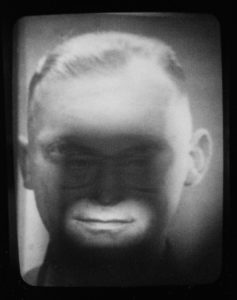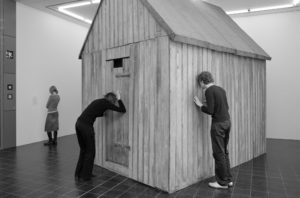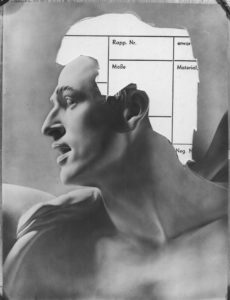FEATURED ESSAY
How and when do artists become complicit with power, entangled in its strategies that sometimes surpass their awareness? German filmmaker Lutz Dammbeck’s perspective is unique. Perhaps it is the result of Dammbeck being part of a minority of artists that were able to leave socialist East Germany in 1986 for the Western liberal-capitalist part of the country. The director allows us to share his viewpoint which, although highly subjective, appears nonetheless cautiously observing, impartial and even strangely ahistorical at times. From 1992-2003, Dammbeck created a four-part series in which he traces the ways art merges with power, talking to artists and intellectuals who, after the heights of their careers, sometimes abruptly find themselves marginalized and sidelined by an unforeseen historical change. In the process, he uncovers a complex of creators, institutions and a legacy of ideas from Nazi to GDR art, Viennese antimodernist actionism, to Silicon Valley Hippies and cybernetics, and invites us to step outside, to estrange ourselves from our own historical context.
Lutz Dammbeck’s documentary tetralogy Kunst und Macht Zeit der Götter/Time of Gods, Dürers Erben/Dürer’s Heirs, Das Meisterspiel/ Master Game, Das Netz/The Net) was screened at the University of Melbourne in four consecutive weeks in August 2018. This event was convened by writer Giles Simon Fielke (Artist Film Workshop www.artistfilmworkshop.org/) and critic and curator Nicolas Hausdorf (Arena— Australian Magazine for Political, Social and Cultural Commentary – www.arena.org.au), and organized in cooperation with the Goethe Institute Melbourne, the University of Melbourne, and the Artist Film Workshop. Each time, the room was filled to the brim with students, alumni and art enthusiasts engaged in discussions how far Dammbeck’s powerful images can be transmitted across time and place, and what remains of their influence at the end of the 20th century and beyond. Nicholas Hausdorf’s essay reflects on the practices of an exceptional artist and his ideas about the allures of power and art.



Kunst und Macht. Lutz Dammbeck in Australia
“We tend all too easily to forget that our reality comes to us through the media, the tragic events of the past included. This means that it is too late to verify and understand them historically, for precisely what characterises our century’s end is the fact that the tools of historical intelligibility have disappeared.” (Jean Baudrillard, “Necrospective around Martin Heidegger”)
In an odd paragraph of his book “Finis Germania” that topped German book reading charts for months, despite being blacklisted and taken off the prestigious “Spiegel” bestseller list, the controversial German author Rolf Peter Sieferle asserts that the world is divided into two camps: tragic and non-tragic peoples. The tragic peoples include the Germans, the Russians and the Jews, Alternatively, Anglo-Saxons like those who continue to decisively shape contemporary Australian culture, are described as non-tragic. History drips from them, Sieferle implies, like it does from a raincoat. [1]
Admittedly, it would be rude to argue that Australian culture is static and not pervaded by the ongoing trauma and tragedy of the colonial experience and legacy, but it is certain that for Australia the idea of history is also marked by a strong sense of continuity. Its cityscapes, for example, lack Berlin’s or Leipzig’s drastic iconoclasm of eclectic experimental styles as a result of bombing campaigns, lost wars, regime collapse and ensuing overtly stylized and ostentatious new beginnings.
This discontinuity and tragedy of German culture might become most palpable when, as is the case in those current unbearably hot European summer months, tourists stroll along Berlin’s boulevard Unter den Linden: The visitor might stop at one of the avenue’s neoclassical portals and find the “Neue Wache” (New Guardhouse) monument. This building – one amongst many by the great Prussian architect Karl Friedrich Schinkel that coin this central part of Berlin – is a particularly interesting witness to the profound changes that have swept the city’s recent history: Originally constructed by Frederic William III for the soldiers killed in action during the Napoleonic wars in 1816, the memorial shifted its meaning to commemorating the soldiers of WWI in 1931, to become the memorial for the victims of fascism and militarism during the period of the socialist German Democratic Republic in 1960. Finally, after the reunification of the two German states in 1990, it was again reimagined in 1993 to become a memorial for the “victims of war and dictatorship”.
The place has thus become reinterpreted under every different ideological regime in modern Berlin. We may therefore imagine the New Guardhouse as a place of commemorative promiscuity. The incisive ideological transformations in Germany in the 20th century have left a legacy of uncertainty and instability that must seem rather abstract to nations with more continuous recent histories such as Australia. Meanwhile, a history that is moved and varied in this way is bound to favor the adoption of a rather critical and distanced stance vis-à-vis the status quo. Similar to the child in a divorce, who lost the familial emotional safe place, the citizen who has experienced the radical break of regime change adopts a more cautious distance to the present, away from cozy ideological-political certainties. This citizen knows that morose and inflated institutions can sometimes seem more stable than they are and quickly collapse under the weight of rapidly shifting economic and geopolitical realities. How would a future regime look at the present one, this citizen might come to ask. Which events would it highlight and commemorate positively, and at which would it frown in horror?
There could hardly be any artist who embodies the historical instability and uncertainty of German history better than Lutz Dammbeck, born in Leipzig in 1948. Leipzig was part of the Soviet-occupied territory before the socialist East German state was founded in 1949. After graduating from the Leipziger Hochschule für Grafik und Buchkunst, Dammbeck worked as a freelance artist in the DEFA Studio für Trickfilme in Dresden and created animated short films. Back then this was a space for critical artists and dissidents to produce subtle sociopolitical reflections and commentary on the repressive East-Berlin dictatorship. Some of Dammbeck‘s work fell victim to censorship and a few of his exhibitions were prohibited. In 1986, Dammbeck and his family were finally allowed to leave East Germany. They profited from East Germany’s policy of selectively granting exit permits to relieve the country of some of the mounting pressure of increasingly organized and popular anti-government movements. Three years later, the popular movements would play a central role in the fall of the Berlin wall and the subsequent reunification of the German state.
Arriving in West-German Hamburg, Dammbeck meanwhile refrained from the temptation of many a dissident to uncritically (and profitably) join in the pervasive chorus of early 1990s liberal-capitalist triumphalism. Rather, he retained a more nuanced and critically observing position. This distance of the observer is what characterizes a series of documentaries he produced between 1992 and 2004, later assembled as the tetralogy “Art and Power”.
The perils of suspending judgment
(…) I happened to see a documentary on television about the first Auschwitz trial in Frankfurt am Main. I saw gray and blurred pictures. The trial seemed soberer and more unspectacular than the staged theatricality and the pomp of the Nuremberg Trials, more like a work situation. It was late, and I was a little drunk. I turned off the TV. Yet a thought stuck in my brain: Wouldn’t my generation have the same thing to do with their fathers? Go there and ask questions about why it did go wrong, but not repeat the mistake of the 1968 generation and cast a judgment. Just leave the story like it was told. (Lutz Dammbeck, Durer’s Heirs)
To this day, Dammbeck’s documentaries have frequently attracted the ire of critics and viewers alike. Reading the original response of the press in the 1990s to contemporary criticism, the most infuriating aspect of Dammbeck’s work seems to be his lack of an overtly critical commentary of his interview partners. Whether it is observing Nazi or socialist GDR art, critics have accused Dammbeck of being too complacent and uncritical with his protagonists. Perhaps, this too is the position of a person who has become ideologically homeless, suspicious of power, someone who does not want to identify with the self-righteous position of the current winner, the unchallenged meta-voice behind the camera, allowed to produce definite meaning.
Arguably, to this day, to be a quiet observer and seriously engaging with marginalized positions while suspending judgment continues to risk infuriating all sides and has little space in a culture that thrives on the social media logic of polarization, echo chambers and badge commitments to political phraseology. Communist Capitalist! Fascist!: More than ever, these words have become mere catch-all phrases and empty-meaning-and-selective-history containers which can signify something different to everyone who uses or identifies with them. Rather than clarifying the conceptual debate, they increasingly act to prevent any sort of meaningful political discussion which attempts to reconcile, nuance and synthesize instead of divide.
Lutz Dammbeck’s method could not be more contrasting. When talking to the protagonists, we can hear his own voice inquire skeptically and stoically, but there is no easy wholesale judgment from this position of historical retrospection, no feelings of superiority. When investigating the Nazi sculptor and Hitler protegé Arno Breker, for example, instead of condemning and demonizing the entirety of philosophical and aesthetic influences culminating in Nazism, Dammbeck does something infinitely more subtle and precise. He asks “at what point did it become monstrous?”
Modernity and its discontents
“It seemed increasingly clear to me that we actually know nothing about this relatively short period of time. (…) This idea seems absurd and curious, of course, given the number of books, films and explanations about fascism and the years between 1933 and 1945, which grow daily and pile up into high mountains, but we know (almost) nothing about it. And we won’t learn much more about it either.” (Lutz Dammbeck, Film Diary)
In many ways, Dammbeck’s documentaries read like an archeology of what contemporaries have dubbed the culture wars – the frictions of the politically varied radical reappraisals and critiques of the present whose main logistical vector is the internet as a crowdsourced archive and alternative civilization excavation/dream machine. Even formally, Dammbeck anticipates the internet age’s aesthetic of ‘post-critical’ enclave culture: His investigations are as highly personal and subjective, as they are non-linear and rhizomatic – hyperlinked – of sorts. Perhaps prototypical of the more recent works of Adam Curtis or Mark Lombardi, in Dammbeck’s work research becomes an art form in and of its own.
In terms of content, “Art and Power” constructs the 20th century as an aesthetic-political antagonism between the forces of modernity and antimodernity. It thereby renders intelligible current cultural-political debates in the same legacy. By investigating the champions of antimodernity and its (German) romantic intellectual center, Dammbeck portrays the origins of a great deal of today’s political (and proto-political) movements assembling those enemies and losers of modernity: the alt-right, ethno-nationalists, traditionalists, luddites [2], MGTOW [3] etc. He thereby portrays modernity in all its ambiguity, this force dubbed a “positive barbarism” by Walter Benjamin which has arguably both lead to unprecedented levels of societal freedom and liberation, but, in its permanent and ruthless challenge to tradition and iconoclastic desire to desacralize, revolutionize and overthrow, also created a legacy of instability, alienation and uprooted cultural anxiety.
By pursuing the legacy of anti-modernism in the West [4], with all its internal contradictions [5] and obliterated cultural grievances, he inevitably arrives at an investigation of modernity itself.
The last part of “Art and Power” mysteriously and evocatively subtitled “The Net – LSD, the Unabomber, and the Internet”, which managed to propel Dammbeck to a certain underground fame beyond the German post-reunification context, excavates modernism’s neglected material substructure and investigates in how far the current cultural trajectory is also the result of the very real experiments in cultural engineering (now often an accusation leveled at progressives by ‘liberal’ conservatives).
Such an enterprise again risks causing disquiet and unease. After all, while it is generally accepted that fascist and socialist regimes maintain a tight grip on their cultural and artistic production, the role of liberal regimes remains comparatively shrouded in mystery. Isn’t it precisely the claim that liberal states grant full freedom of expression? “The Net” answers to this claim by revealing how the contemporary Western anti-authoritarian personality has its origins not in mere chance and an arbitrary cultural trajectory usually associated with emancipatory 1960s youth culture. Rather, viewers learn that the development of culture has been “helped along” by hidden forces of the CIA-funded Macy Conferences with the active participation of a techno-scientific elite. Inspired by the horrors of the Second World War and Theodor Adorno’s study on the authoritarian personality and to forever avert the dangers of fascism, this complex of creators and intellectuals supported by the parapolitical institutions of the state devised a concerted effort of a scientific destruction of the authoritarian personality–type associated with the specter of fascism in general and Germany in particular.
Dammbeck thus dispels the last myths of the 20th century of an autonomy of the cultural sphere in the Western world and joins groundbreaking works such as those by Francis Stonor Saunder [6] on the CIA’s funding of abstract expressionism during the Cultural Cold War, or Gabriel Rockhill’s recent investigation of the CIA’s anticommunist promotion of postmodern “French” theory in US universities [7]. Dammbeck’s work thus forces us to radically reevaluate the Western cultural legacy of the 20th century which continues to exert its influence on aesthetics and politics today.
The filmmaker thereby reasserts the (ultimately very modern as ruthlessly critical) perspective of the internet age as one of popularized radical disenchantment. Exposed to the meticulously crowdsourced archives of internet information, political theory, philosophy, and culture lose their innocence as independently developing ideas and instead become reattached to a network of people instrumentalizing them for concrete interests and the pursuit of political power. As viewers, we witness a sort of Deep Sociology, a materialist critique of ideas, which is re-connecting thinkers and the formation of ideas to institutions: the usually hidden process of the creation of a superstructure by a network of individuals working for state, cultural and economic institutions [8] – l’eternel retour du concret.
With Art and Power, Dammbeck invites us to observe his careful and evocative snapshots of culture-as-power-constellation: an assemblage of personalized portraits, interviews and institutional connections constituting Gramsci’s historical blocks as tales of cultural dominance and hegemony. In the puzzled faces and unstable positions of the protagonists, who suddenly find themselves disenfranchised from the apex of power and cast into suspicion, we can read the tales of a volatility of ideological hegemony and dominant narratives with creators as their sometimes unconscious and tragic protagonists.
Ultimately, we should view their example as one of political hope. One that allows us to step outside and estrange ourselves from our own historical context. It reminds us of our own active role in constantly creating and reassessing culture – and those things can change, and a final judgment has not yet been cast.
Nicolas Hausdorf is an editor, analyst and essayist living in Melbourne. His essay Superstructural Berlin was published by Zero Books in 2015.
Notes
[1] See also “Kultur und Skandal“ in arena – Australian magazine of political, cultural and social commentary (no. 152)
[2] Paradoxically often inspired by Dammbeck‘s interviewees and the pop-culture status of Ted Kaczinsky, the US anti-technology terrorist, aka the Unabomber.
[3] Men Going Their Own Way, a movement that interprets men as being structurally disadvantaged in the war of the sexes and proclaiming a sort of gendered secession from women corrupted by contemporary culture.
[4] In Nazi Art (“Time of Gods”), GDR art (“Durer’s Heirs”) and a circle of 1990s right-wing avantgardists based around Vienna’s Akademie der Kunst (“Master Game”)
[5] The modernist situationist strategies of Viennese antimodernists shown in “Master Game”, for example.
[6] See for example “Modern Art was CIA “weapon”, The Independent, 22 October 1995 and “Who paid the piper. The Cultural Cold War, 1999.
[7] “The CIA reads French Theory: On the intellectual labor of dismantling the cultural left“, The Philosophical Salon (2017) available from http://thephilosophicalsalon.com/the-cia-reads-french-theory-on-the-intellectual-labor-of-dismantling-the-cultural-left/
[8] Dammbeck in this way also anticipates philosophy’s New Realism of the late 2000s.
Credits
Picture 1 – ”Versuchsanordnung (1), 1978“, copyright Foto: Karin Plessing
Picture 2 – ”Versuchsanordnung 3, 1988-1990″, copyright Foto: Bildmischer LKA Düsseldorf
Picture 3 – ”cabin, 2006“, copyright Foto: Christoph Irrgang
Picture 4 – ”Versuchsanordnung (2), 1978“, copyright Foto: Karin Plessing
Other Sources
Goethe Institute Melbourne Link to the event Kunst und Macht – https://www.goethe.de/ins/au/en/ver.cfm?fuseaction=events.detail&event_id=21302682
DEFA-Stiftung, biography Lutz Dammbeck – http://www.defa-stiftung.de/DesktopDefault.aspx?TabID=1677
Lutz Dammbeck: Herakles Konzept – http://www.herakleskonzept.de/material/index.php/herakles-konzept-95.html
